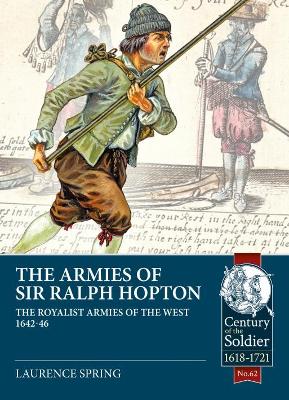Century of the Soldier
7 total works
The Battle of the White Mountain 1620 and the Bohemian Revolt, 1618-1622
by Laurence Spring
Published 15 May 2018
The Battle of the White Mountain and the Bohemian Revolt, 1618-1622 looks not only at the battle of the White Mountain, but also the campaigns and events leading up to the battle, such as the Bohemian Army's march on Vienna, the sieges of Pilsen and Bautzen and the battle of Zablat. These events are often described using the words of the protagonists themselves.
It also examines the armies that took part in these campaigns, the soldiers from which came not only from Bohemia, but also Britain, the Dutch Republic, France, the Holy Roman Empire, Hungary, Poland, Spain, the Spanish Netherlands and Transylvania.
However, even before the battle of the White Mountain the seeds had been sewn for the war to last 30 years and such was the Emperor Ferdinand's Counter Reformation policy that when the sword which executed some Bohemian rebels when on display in the nineteenth century it had to be removed for fear of a public disturbance and has been compared with the occupation of Czechoslovakia by the Nazi Germany in 1938.
Therefore this book is essential reading to anyone interested in the wars of the early seventeenth century, not just the Thirty Years War.
It also examines the armies that took part in these campaigns, the soldiers from which came not only from Bohemia, but also Britain, the Dutch Republic, France, the Holy Roman Empire, Hungary, Poland, Spain, the Spanish Netherlands and Transylvania.
However, even before the battle of the White Mountain the seeds had been sewn for the war to last 30 years and such was the Emperor Ferdinand's Counter Reformation policy that when the sword which executed some Bohemian rebels when on display in the nineteenth century it had to be removed for fear of a public disturbance and has been compared with the occupation of Czechoslovakia by the Nazi Germany in 1938.
Therefore this book is essential reading to anyone interested in the wars of the early seventeenth century, not just the Thirty Years War.
True, the concept of Britain dates back to Roman times, but it was James I that founded Britain in the modern sense. With his accession to the throne in 1603 for the first time Scotland, England, Wales and Ireland were united - with James bestowing on himself the title of 'King of Great Britain'. Before this time, Scots and Irishmen may have served in the English Army as mercenaries, but it was known as an English Army - but now the King's (or British) flag flew over the castles and forts throughout the land. The army raised by Charles I in 1625 for his war against Spain -and subsequently, with France - is most famous for its failure. However, it is one of the best-documented armies of the early 17th century. Using archival and archaeological evidence, the first half of the book covers the lives of the officers and men serving in the army at this time - as well as the women who accompanied them. The author discusses the origins of officers and why they decided to serve in the army - and how the men from England, Scotland and Ireland were recruited (as well as how they were clothed and what they ate; the medical care; and the tactics used by the army at this time). It also covers the hidden faction of tailors, armourers and merchants who helped to put the army into the field. The second half of the book covers not only the expeditions to Cadiz, the Isle de Rhe and the siege of La Rochelle, but also their effect on an England who feared a Spanish (and later a French) invasion. Also covered are the campaigns of Count Ernest von Mansfeldt's and Sir Charles Morgan's armies at this time, which fought at Breda, Dessau Bridge and against the forces of the Holy Roman Empire. The final chapter looks at what became of the soldiers and their widows once the army had been disbanded - therefore, the book will be essential reading for anyone interested in Early Modern History, including the English Civil War and the Thirty Years War.
Albrecht von Wallenstein! His very name is synonymous with the Thirty Years War. From a poor nobleman he rose to become the Duke of Friedland and Mecklenburg. Many see his assassination at Eger in 1634 as the end of the "interesting" period of the war, since he was the last of the war's titans to be killed.
However, his army continued to serve the Emperor loyally to the end of the war, and a few regiments existed well into the 20th century. These would see action in the First World War as part of the Austrian Army and, after the Austrian Anschluss of March 1938, in the German Army during the Second World War.
Despite Wallenstein's Army being infamous, very little has been written about it, especially in English. However, by using archives from record offices from Germany, Czechoslovakia (formerly Bohemia), Sweden and Britain, as well as the latest archaeological evidence from mass graves of the Thirty Years War period, this book looks to rectify this by giving a vivid account of what life was like for a soldier in Wallenstein's Army.
The chapters include recruiting the army, its officers, as well as the logistics of clothing, equipping and feeding the army. There are also chapters on regimental colours, how to quarter an army, and the arms industry, plus case studies on siege warfare using Stralsund and the Alte Veste as an example, as well as Wallenstein's tactics at the Battle of Lutzen.
It also dispels the myths that have arisen about Wallenstein's Army, such as it being one of the first to be well clothed during the war, and did not follow the Catholic League's General Johan von Tilly's alleged doctrine of "a ragged soldier and a bright musket" (which in itself is incorrect).
Therefore this book will be essential reading to anyone interested in the Thirty Years War, the English Civil War or warfare in the early modern period.
However, his army continued to serve the Emperor loyally to the end of the war, and a few regiments existed well into the 20th century. These would see action in the First World War as part of the Austrian Army and, after the Austrian Anschluss of March 1938, in the German Army during the Second World War.
Despite Wallenstein's Army being infamous, very little has been written about it, especially in English. However, by using archives from record offices from Germany, Czechoslovakia (formerly Bohemia), Sweden and Britain, as well as the latest archaeological evidence from mass graves of the Thirty Years War period, this book looks to rectify this by giving a vivid account of what life was like for a soldier in Wallenstein's Army.
The chapters include recruiting the army, its officers, as well as the logistics of clothing, equipping and feeding the army. There are also chapters on regimental colours, how to quarter an army, and the arms industry, plus case studies on siege warfare using Stralsund and the Alte Veste as an example, as well as Wallenstein's tactics at the Battle of Lutzen.
It also dispels the myths that have arisen about Wallenstein's Army, such as it being one of the first to be well clothed during the war, and did not follow the Catholic League's General Johan von Tilly's alleged doctrine of "a ragged soldier and a bright musket" (which in itself is incorrect).
Therefore this book will be essential reading to anyone interested in the Thirty Years War, the English Civil War or warfare in the early modern period.
The Bavarian Army During the Thirty Years War, 1618-1648
by Laurence Spring
Published 15 August 2017
The Bavarian Army has been overshadowed by those of Gustavus Adolphus' and Wallenstein's Armies, but it was one of only a few armies to have fought throughout the Thirty Years War, first as part of the Catholic League and then an independent army after the Peace of Prague. Among the generals of the Bavarian Army were Count Johan von Tilly and Gottfried von Pappenheim, who are two of the most famous generals of the war.
This book covers not only the Bavarian Army's organisation, but also has chapters on recruitment, officers, clothing, weaponry, pay and rations of a soldier during the Thirty Years War. As well as life and death in the army, this book also looks at the women who accompanied it.
The chapter on 'civilians and soldiers' looks at the impact of the war on the civilian population, their reaction to it and the infamous sack of Magdeburg which sent shockwaves across Europe. This chapter also looks at the impact on Bavaria by having Swedish, Spanish and Imperialist troops quartered upon it and how this affected the country's war effort. In addition there are chapters on regimental colours and a detailed look into the tactics of the time, including those of Spain, Sweden and the Dutch. As well as using archival and archaeological evidence to throw new light on the subject the author has used several memoirs written by those who served in the army during the war, including Peter Hagendorf who served in Pappenheim 's Regiment of Foot from 1627 until the regiment was disbanded after the war. Hagendorf's vivid account is unique because not only is it a full account of the life of a common soldier during the war, but also records the human side of campaign, including the death of his two wives and all but two of his children.
This book is essential reading to anyone interested in the wars of the early seventeenth century, not just the Thirty Years War.
This book covers not only the Bavarian Army's organisation, but also has chapters on recruitment, officers, clothing, weaponry, pay and rations of a soldier during the Thirty Years War. As well as life and death in the army, this book also looks at the women who accompanied it.
The chapter on 'civilians and soldiers' looks at the impact of the war on the civilian population, their reaction to it and the infamous sack of Magdeburg which sent shockwaves across Europe. This chapter also looks at the impact on Bavaria by having Swedish, Spanish and Imperialist troops quartered upon it and how this affected the country's war effort. In addition there are chapters on regimental colours and a detailed look into the tactics of the time, including those of Spain, Sweden and the Dutch. As well as using archival and archaeological evidence to throw new light on the subject the author has used several memoirs written by those who served in the army during the war, including Peter Hagendorf who served in Pappenheim 's Regiment of Foot from 1627 until the regiment was disbanded after the war. Hagendorf's vivid account is unique because not only is it a full account of the life of a common soldier during the war, but also records the human side of campaign, including the death of his two wives and all but two of his children.
This book is essential reading to anyone interested in the wars of the early seventeenth century, not just the Thirty Years War.
Nothing sums up the tragedy of the English Civil War more than the friendship between Sir William Waller and his opponent Sir Ralph Hopton as "this war without an enemy."However, Waller was also a general respected by both sides during the war, the Royalist Colonel Walter Slingsby described him as "the fox" and the "best shifter and chooser of ground when he was not master of the field." The Parliamentarian John Vicars in his England's Worthies published in 1647 refers to Waller as "one of the most impregnable offensive and defensive walls of the kingdom." His victories in 1642 and early 1643 earned him the nickname of "William the Conqueror," and due to his tactics of marching by night to surprise his enemy, the "Night Owl."It was Waller who also first mentioned the need for the formation of the New Model Army.
Using contemporary accounts to describe events, this book looks at Waller's campaigns from the siege of Portsmouth in June 1642 to April 1645 when his army was disbanded. It includeshis victories in the West in 1643, the raising of a new army in August 1643, the sieges of Basing House and Arundel Castle along with the defence of Farnham and the storming of Alton. Also included is Waller's many battles including Lansdown, Roundway Down, Cheriton, Cropredy Bridge, and the Second Battle of Newbury.
The book also covers the logistics of putting Waller's Army into the field, including clothing, arms, and taxation as well as the tension between Waller and the Earl of Essex.
Using contemporary accounts to describe events, this book looks at Waller's campaigns from the siege of Portsmouth in June 1642 to April 1645 when his army was disbanded. It includeshis victories in the West in 1643, the raising of a new army in August 1643, the sieges of Basing House and Arundel Castle along with the defence of Farnham and the storming of Alton. Also included is Waller's many battles including Lansdown, Roundway Down, Cheriton, Cropredy Bridge, and the Second Battle of Newbury.
The book also covers the logistics of putting Waller's Army into the field, including clothing, arms, and taxation as well as the tension between Waller and the Earl of Essex.
Nothing sums up the tragedy of the English Civil War more than the friendship between Sir Ralph Hopton and the parliamentarian general Sir William Waller as "this war without an enemy." Hopton was one of the first commanders to support the king and helped secure Cornwall for the Royalist Cause.
In fact Sir Ralph Hopton commanded three armies during the Civil War; the first was made up of the famous Cornish infantry, which would become the backbone of the Royalist war effort in the West. This army was absorbed into Prince Maurice's army after the fall of Bristol to the Royalists in July 1643. His second army was raised during the autumn of 1643 and was disbanded to reinforce the King's Oxford Army after the battle of Cheriton. Finally Hopton commanded the remnants of the royalist army in the West during the death throes of the Royalist cause in 1646.
By using contemporary sources this book describes the life, and death, of a soldier during the Civil War. Chapters include recruitment, clothing, equipping and training of Hopton's armies as well as his campaigns, including those of Prince Maurice, Sir Richard Grenville and George Lord Goring. It also looks at the divisions within the royalist high command which ultimately lost King Charles the war. It also looks at what happened to these soldiers once the fighting was over.
In fact Sir Ralph Hopton commanded three armies during the Civil War; the first was made up of the famous Cornish infantry, which would become the backbone of the Royalist war effort in the West. This army was absorbed into Prince Maurice's army after the fall of Bristol to the Royalists in July 1643. His second army was raised during the autumn of 1643 and was disbanded to reinforce the King's Oxford Army after the battle of Cheriton. Finally Hopton commanded the remnants of the royalist army in the West during the death throes of the Royalist cause in 1646.
By using contemporary sources this book describes the life, and death, of a soldier during the Civil War. Chapters include recruitment, clothing, equipping and training of Hopton's armies as well as his campaigns, including those of Prince Maurice, Sir Richard Grenville and George Lord Goring. It also looks at the divisions within the royalist high command which ultimately lost King Charles the war. It also looks at what happened to these soldiers once the fighting was over.






